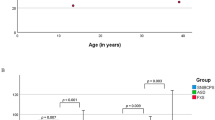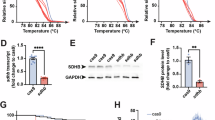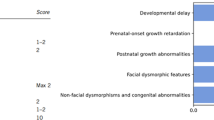Abstract
Chromatin remodeling is an important system controlling gene expression. CHD3, which is a causative gene of Snijders Blok-Campeau syndrome (SNIBCPS), is a member of the chromodomain helicase DNA-binding (CHD) family related to chromatin remodeling. SNIBCPS is characterized by developmental delay (DD), intellectual disability (ID), macrocephaly, and facial features including a prominent forehead and hypertelorism. Hypersociability/overfriendliness is a notable behavioral feature in patients. Here, we describe five SNIBCPS patients with CHD3 variants from four families, including a sibling pair caused by parental gonosomal mosaicism. We observed two distinct phenotypes in our patients in accordance with previous observations. Phenotype 1: macrocephaly, hypertelorism, overgrowth, DD, and ID; and Phenotype 2: microcephaly, growth retardation, DD, and ID. Phenotype 1 was consistent with the typical SNIBCPS phenotype, while Phenotype 2 was distinct. To understand further the features of the patients with SNIBCPS, we generated chd3-knockout (KO) zebrafish using CRISPR-Cas9 genome editing. No morphological changes were observed in chd3-KO zebrafish. However, behavioral tests showed that chd3-KO zebrafish had strong and sustained interest in others, and were less aggressive toward others, suggesting a recapitulation of the hypersociability/overfriendliness phenotype in patients with SNIBCPS. Metabolomic analysis using whole brains showed changes in metabolites processed by specific mitochondrial enzymes in chd3-KO zebrafish. The administration of metformin, which reportedly ameliorates mitochondrial dysfunction and behavioral abnormalities, attenuated the abnormal behavior of chd3-KO zebrafish. Our study helps delineate the phenotypes of patients with SNIBCPS, provides insights into a characteristic behavior of the disease, and suggests a potential treatment to improve the behavioral symptoms of patients.
This is a preview of subscription content, access via your institution
Access options
Subscribe to this journal
Receive 12 print issues and online access
$259.00 per year
only $21.58 per issue
Buy this article
- Purchase on SpringerLink
- Instant access to full article PDF
Prices may be subject to local taxes which are calculated during checkout




Similar content being viewed by others
Data availability
The data are not available due to ethical restrictions.
References
Narlikar GJ, Sundaramoorthy R, Owen-Hughes T. Mechanisms and functions of ATP-dependent chromatin-remodeling enzymes. Cell. 2013;154:490–503.
Clapier CR, Iwasa J, Cairns BR, Peterson CL. Mechanisms of action and regulation of ATP-dependent chromatin-remodelling complexes. Nat Rev Mol Cell Biol. 2017;18:407–22.
Marfella CG, Imbalzano AN. Imbalzano. The Chd family of chromatin remodelers concetta. Chd Fam Chromatin Remodel. 2007;605:105–12.
Cardoso AR, Lopes-Marques M, Oliveira M, Amorim A, Prata MJ, Azevedo L. Genetic variability of the functional domains of chromodomains helicase DNA-binding (CHD) proteins. Genes. 2021;12:1–15.
Pilarowski GO, Vernon HJ, Applegate CD, Boukas L, Cho MT, Gurnett CA, et al. Missense variants in the chromatin remodeler CHD1 are associated with neurodevelopmental disability. J Med Genet. 2018;55:561–6.
Carvill GL, Heavin SB, Yendle SC, McMahon JM, O’Roak BJ, Cook J, et al. Targeted resequencing in epileptic encephalopathies identifies de novo mutations in CHD2 and SYNGAP1. Nat Genet. 2013;45:825–30.
Suls A, Jaehn JA, Kecskés A, Weber Y, Weckhuysen S, Craiu DC, et al. De novo loss-of-function mutations in CHD2 cause a fever-sensitive myoclonic epileptic encephalopathy sharing features with dravet syndrome. Am J Hum Genet. 2013;93:967–75.
Snijders Blok L, Rousseau J, Twist J, Ehresmann S, Takaku M, Venselaar H, et al. CHD3 helicase domain mutations cause a neurodevelopmental syndrome with macrocephaly and impaired speech and language. Nat Commun. 2018;9:1–12.
Weiss K, Terhal PA, Cohen L, Bruccoleri M, Irving M, Martinez AF, et al. De novo mutations in CHD4, an ATP-dependent chromatin remodeler gene, cause an intellectual disability syndrome with distinctive dysmorphisms. Am J Hum Genet. 2016;99:934–41. https://doi.org/10.1016/j.ajhg.2016.08.001.
Sifrim A, Hitz MP, Wilsdon A, Breckpot J, Turki SHA, Thienpont B, et al. Distinct genetic architectures for syndromic and nonsyndromic congenital heart defects identified by exome sequencing. Nat Genet. 2016;48:1060–5.
Parenti I, Lehalle D, Nava C, Torti E, Leitão E, Person R, et al. Missense and truncating variants in CHD5 in a dominant neurodevelopmental disorder with intellectual disability, behavioral disturbances, and epilepsy. Hum Genet. 2021;140:1109–20. https://doi.org/10.1007/s00439-021-02283-2.
Bernier R, Golzio C, Xiong B, Stessman HA, Coe BP, Penn O, et al. Disruptive CHD8 mutations define a subtype of autism early in development. Cell. 2014;158:263–76. https://doi.org/10.1016/j.cell.2014.06.017.
Coursimault J, Lecoquierre F, Saugier-Veber P, Drouin-Garraud V, Lechevallier J, Boland A, et al. Hypersociability associated with developmental delay, macrocephaly, and facial dysmorphism points to CHD3 mutations. Eur J Med Genet. 2021;64:104166.
Li H, Durbin R. Fast and accurate long-read alignment with Burrows-Wheeler transform. Bioinformatics. 2010;26:589–95.
Li H, Handsaker B, Wysoker A, Fennell T, Ruan J, Homer N, et al. The sequence alignment/map format and SAM tools. Bioinformatics. 2009;25:2078–9.
McKenna A, Hanna M, Banks E, Sivachenko A, Cibulskis K, Kernytsky A, et al. The genome analysis toolkit: a MapReduce framework for analyzing next-generation DNA sequencing data. Genome Res. 2010;20:1297–303.
Wang K, Li M, Hakonarson H. ANNOVAR: functional annotation of genetic variants from high-throughput sequencing data. Nucleic Acids Res. 2010;38:1–7.
Cingolani P, Platts A, Wang LL, Coon M, Nguyen T, Wang L, et al. A program for annotating and predicting the effects of single nucleotide polymorphisms, SnpEff: SNPs in the genome of Drosophila melanogaster strain w1118; iso-2; iso-3. Fly. 2012;6:80–92.
Enomoto Y, Tsurusaki Y, Yokoi T, Abe-Hatano C, Ida K, Naruto T, et al. CNV analysis using whole exome sequencing identified biallelic CNVs of VPS13B in siblings with intellectual disability. Eur J Med Genet. 2020;63:103610. https://doi.org/10.1016/j.ejmg.2018.12.015.
Fromer M, Moran JL, Chambert K, Banks E, Bergen SE, Ruderfer DM, et al. Discovery and statistical genotyping of copy-number variation from whole-exome sequencing depth. Am J Hum Genet. 2012;91:597–607. https://doi.org/10.1016/j.ajhg.2012.08.005.
Kelsh RN, Brand M, Jiang YJ, Heisenberg CP, Lin S, Haffter P, et al. Zebrafish pigmentation mutations and the processes of neural crest development. Development. 1996;123:369–89.
Nishimura Y, Murakami S, Ashikawa Y, Sasagawa S, Umemoto N, Shimada Y, et al. Zebrafish as a systems toxicology model for developmental neurotoxicity testing. Congenit Anom. 2015;55:1–16.
Kotani H, Taimatsu K, Ohga R, Ota S, Kawahara A. Efficient multiple genome modifications induced by the crRNAs, tracrRNA and Cas9 protein complex in zebrafish. PLoS ONE. 2015;10:1–16.
Adachi Y, Higuchi A, Wakai E, Shiromizu T, Koiwa J, Nishimura Y. Involvement of homeobox transcription factor Mohawk in palatogenesis. Congenit Anom. 2022;62:27–37.
Stewart AM, Nguyen M, Wong K, Poudel MK, Kalueff AV. Developing zebrafish models of autism spectrum disorder (ASD). Prog NeuroPsychopharmacol Biol Psychiatry. 2014;50:27–36. https://doi.org/10.1016/j.pnpbp.2013.11.014.
Tomar S. Converting video formats with FFmpeg. Linux J. 2006;2006:10.
Yamanaka O, Takeuchi R. UMATracker: an intuitive image-based tracking platform. J Exp Biol. 2018;221:1–5.
Wickham H. ggplot2: Elegant Graphics for Data Analysis. 3rd ed. Springer: Verlag, 2016.
Wickham H, Averick M, Bryan J, Chang W, McGowan L, François R, et al. Welcome to the Tidyverse. J Open Source Softw. 2019;4:1686.
Hong F, Breitling R, McEntee CW, Wittner BS, Nemhauser JL, Chory J. RankProd: a Bioconductor package for detecting differentially expressed genes in meta-analysis. Bioinformatics. 2006;22:2825–7.
Lopez-Ibanez J, Pazos F, Chagoyen M. MBROLE3: improved functional enrichment of chemical compounds for metabolomics data analysis. Nucleic Acids Res. 2023;51:W305–9.
Richards S, Aziz N, Bale S, Bick D, Das S, Gastier-Foster J, et al. Standards and guidelines for the interpretation of sequence variants: a joint consensus recommendation of the American College of Medical Genetics and Genomics and the Association for Molecular Pathology. Genet Med. 2015;17:405–24.
Drivas TG, Li D, Nair D, Alaimo JT, Alders M, Altmüller J, et al. A second cohort of CHD3 patients expands the molecular mechanisms known to cause Snijders Blok-Campeau syndrome. Eur J Hum Genet. 2020;28:1422–31. https://doi.org/10.1038/s41431-020-0654-4.
Aishworiya R, Valica T, Hagerman R, Restrepo B. An update on psychopharmacological treatment of autism spectrum disorder. Neurotherapeutics. 2022;19:248–62. https://doi.org/10.1007/s13311-022-01183-1.
Biag HMB, Potter LA, Wilkins V, Afzal S, Rosvall A, Salcedo-Arellano MJ, et al. Metformin treatment in young children with fragile X syndrome. Mol Genet Genomic Med. 2019;7:1–13.
Amin S, Mallick AA, Edwards H, Cortina-Borja M, Laugharne M, Likeman M, et al. The metformin in tuberous sclerosis (MiTS) study: a randomised double-blind placebo-controlled trial. EClinicalMedicine. 2021;32:100715. https://doi.org/10.1016/j.eclinm.2020.100715.
Nabais Sá, El Tekle MJ, de Brouwer G, Sawyer SL APM, del Gaudio D, Parker MJ, et al. De novo variants in SPOP cause two clinically distinct neurodevelopmental disorders. Am J Hum Genet. 2020;106:405–11.
Nishimura Y, Inoue A, Sasagawa S, Koiwa J, Kawaguchi K, Kawase R, et al. Using zebrafish in systems toxicology for developmental toxicity testing. Congenit Anom. 2016;56:18–27.
Toth M. The other side of the coin: hypersociability. Genes Brain Behav. 2019;18:1–11.
López-Tobón A, Trattaro S, Testa G. The sociability spectrum: evidence from reciprocal genetic copy number variations. Mol Autism. 2020;11:1–13.
Hoffmeister H, Fuchs A, Erdel F, Pinz S, Gröbner-Ferreira R, Bruckmann A, et al. CHD3 and CHD4 form distinct NuRD complexes with different yet overlapping functionality. Nucleic Acids Res. 2017;45:10534–54.
Havugimana PC, Goel RK, Phanse S, Youssef A, Padhorny D, Kotelnikov S, et al. Scalable multiplex co-fractionation/mass spectrometry platform for accelerated protein interactome discovery. Nat Commun. 2022;13:1–8.
Young EJ, Lipina T, Tam E, Mandel A, Clapcote SJ, Bechard AR, et al. Reduced fear and aggression and altered serotonin metabolism in Gtf2ird1-targeted mice. Genes Brain Behav. 2008;7:224–34.
Proulx É, Young EJ, Osborne LR, Lambe EK. Enhanced prefrontal serotonin 5-HT1A currents in a mouse model of Williams-Beuren syndrome with low innate anxiety. J Neurodev Disord. 2010;2:99–108.
Filiou MD, Zhang Y, Teplytska L, Reckow S, Gormanns P, MacCarrone G, et al. Proteomics and metabolomics analysis of a trait anxiety mouse model reveals divergent mitochondrial pathways. Biol Psychiatry. 2011;70:1074–82. https://doi.org/10.1016/j.biopsych.2011.06.009.
Varma VR, Oommen AM, Varma S, Casanova R, An Y, Andrews RM, et al. Brain and blood metabolite signatures of pathology and progression in Alzheimer disease: a targeted metabolomics study. PLoS Med. 2018;15:1–31.
Gómez-Del Arco P, Perdiguero E, Yunes-Leites PS, Acín-Pérez R, Zeini M, Garcia-Gomez A, et al. The chromatin remodeling complex Chd4/NuRD controls striated muscle identity and metabolic homeostasis. Cell Metab. 2016;23:881–92.
Morella IM, Brambilla R, Morè L. Emerging roles of brain metabolism in cognitive impairment and neuropsychiatric disorders. Neurosci Biobehav Rev. 2022;142;104892.
Kulkarni AS, Gubbi S, Barzilai N. Benefits of metformin in attenuating the hallmarks of aging. Institute Physiol Behav. 2016;176:100–6.
Vaubel RA, Rustin P, Isaya G. Mutations in the dimer interface of dihydrolipoamide dehydrogenase promote site-specific oxidative damages in yeast and human cells. J Biol Chem. 2011;286:40232–45.
A O, U M, LF B, A GC. Energy metabolism in childhood neurodevelopmental disorders. EBioMedicine. 2021;69:103474.
Fontaine E. Metformin-induced mitochondrial complex I inhibition: facts, uncertainties, and consequences. Front Endocrinol. 2018;9:23–8.
Acknowledgements
We thank patients and their families for their cooperation.
Funding
This research was supported by the Initiative on Rare and Undiagnosed Diseases (IRUD) (19ek0109301) from the Japan Agency for Medical Research and Development, a Grant-in-Aid for Research on rare and intractable diseases, Health and Labour Sciences Research Grants from the Ministry of Health, Labour and Welfare of Japan, MEXT KAKENHI (no. 221S0002 to KK), the Japan Society for the Promotion of Science, KAKENHI (grant nos. 20K08270 and 23K07283 to KK, 22K06882 to TS, and 23K06355 to YN), the Research Revitalization Program at Mie University Graduate School of Medicine (to YN), and Ikuura Mariko Foundation (to YN).
Author information
Authors and Affiliations
Contributions
KK, YN, and YE designed the study, the main conceptual ideas, and the proof outline. YE analyzed the clinical and genomic data and wrote the manuscript with support from all members. KK, YK, and HM were involved in patients’ medical care and analysis of the clinical and genomic data. TN and YE provided the bioinformatics pipeline for genomic data analysis. SS and NO performed the laboratory experiments. TS generated the chd3-KO zebrafish and performed the metabolome analysis. JK maintained the zebrafish. SY, JK, MO, and HI performed the behavioral analysis of the zebrafish. RS and MY performed the histological analysis of the zebrafish.
Corresponding authors
Ethics declarations
Competing interests
The authors declare no competing interests.
Ethical approval and consent to participate
Written informed consent was obtained from the parents of the patients in accordance with the Kanagawa Children’s Medical Center Review Board and Ethics Committee. This study was approved by the Institutional Animal Care and Use Committee of Mie University (no. 2020-19).
Additional information
Publisher’s note Springer Nature remains neutral with regard to jurisdictional claims in published maps and institutional affiliations.
Supplementary information
Rights and permissions
Springer Nature or its licensor (e.g. a society or other partner) holds exclusive rights to this article under a publishing agreement with the author(s) or other rightsholder(s); author self-archiving of the accepted manuscript version of this article is solely governed by the terms of such publishing agreement and applicable law.
About this article
Cite this article
Enomoto, Y., Shiromizu, T., Yasojima, S. et al. Two distinct phenotypes in Snijders Blok-Campeau syndrome and characterization of the behavioral phenotype in a zebrafish model. Eur J Hum Genet 33, 747–757 (2025). https://doi.org/10.1038/s41431-025-01815-y
Received:
Revised:
Accepted:
Published:
Issue date:
DOI: https://doi.org/10.1038/s41431-025-01815-y
This article is cited by
-
What’s new in EJHG in May 2025?
European Journal of Human Genetics (2025)



